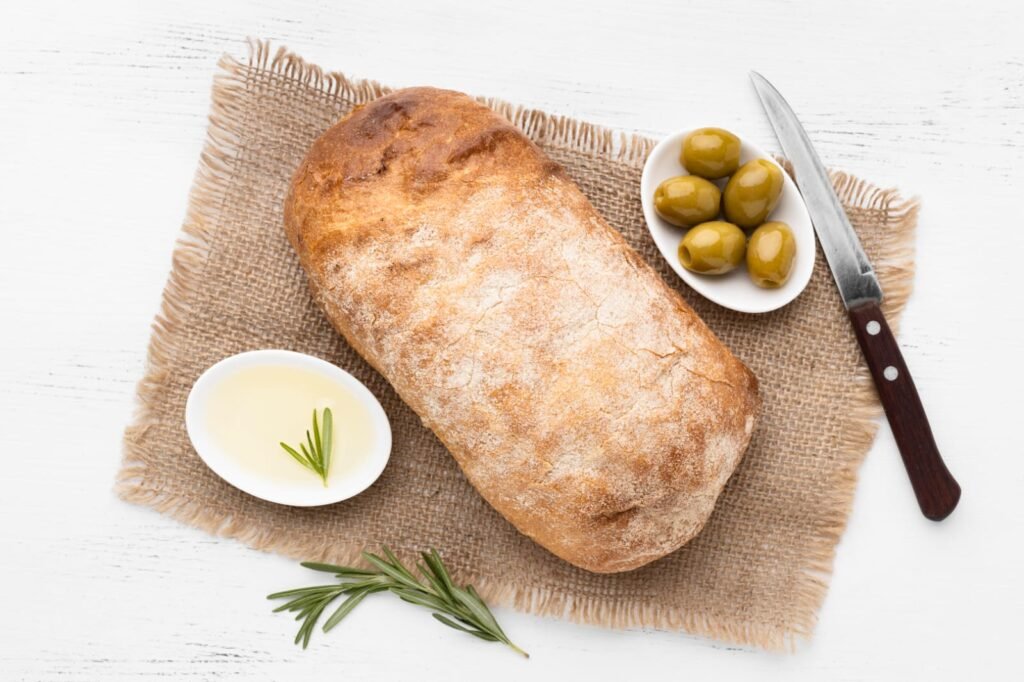If you love the soft, airy texture of ciabatta bread, you’ll be thrilled to know that making it at home is easier than you think! This classic Italian bread, known for its crisp crust and open crumb, is perfect for sandwiches, dipping in olive oil, or enjoying on its own. In this guide, we’ll walk you through a step-by-step process to make perfect ciabatta bread at home.
What is Ciabatta Bread?
Ciabatta bread is a rustic Italian loaf that originated in the 1980s in response to the popularity of French baguettes. Its name, meaning “slipper” in Italian, refers to its flat, elongated shape. What makes ciabatta bread unique is its high hydration level, which creates large air pockets inside and a crispy crust outside.
Why You’ll Love This Homemade Ciabatta Bread Recipe
- Simple Ingredients – No fancy ingredients required, just flour, water, yeast, salt, and olive oil.
- No Kneading Required – This recipe uses a stretch-and-fold method instead of traditional kneading.
- Light & Airy Texture – The high hydration dough results in a chewy, hole-filled interior.
- Perfect for Sandwiches – Its structure makes it great for paninis, bruschetta, or dipping in soups.
Now, let’s dive into the step-by-step process of making ciabatta bread at home.
Ingredients for Ciabatta Bread
To make authentic ciabatta bread, you’ll need:
- 3 ¾ cups (450g) bread flour – Provides the gluten structure.
- 1 ½ teaspoons salt – Enhances flavor.
- 1 teaspoon sugar – Feeds the yeast.
- 1 ½ teaspoons instant yeast – Helps the bread rise.
- 1 ½ cups (360ml) warm water – Activates the yeast and hydrates the dough.
- 1 tablespoon olive oil – Adds moisture and flavor
Read More: Classico Pasta Sauce Review: Which Flavor is Best for Your Recipes?
Step-by-Step Guide to Making Ciabatta Bread
Step 1: Activate the Yeast
In a large mixing bowl, combine warm water, sugar, and yeast. Stir and let it sit for 5-10 minutes until it becomes foamy. This ensures that the yeast is active and ready to make your ciabatta bread rise.
Step 2: Mix the Dough
Add the flour and salt to the yeast mixture. Stir with a wooden spoon or a stand mixer with a dough hook until a sticky dough forms. Unlike other bread recipes, ciabatta bread dough is very wet and sticky, so don’t be tempted to add more flour.
Step 3: First Rise (Bulk Fermentation)
Cover the bowl with plastic wrap and let the dough rise for 1 to 1.5 hours at room temperature until it doubles in size. The dough will be very soft and full of bubbles.
Step 4: Stretch and Fold Method
Since ciabatta bread dough is too sticky to knead, we use the stretch-and-fold technique:
- Lightly oil your hands and work surface.
- Gently stretch one side of the dough and fold it over itself.
- Rotate 90 degrees and repeat the process on all four sides.
- Cover and let it rest for 30 minutes. Repeat this process twice to develop the gluten structure.
Step 5: Shaping the Ciabatta Loaves
- Generously flour your work surface and carefully turn out the dough without deflating it.
- Divide it into two equal portions using a bench scraper.
- Gently shape each portion into a rectangle, keeping as much air inside as possible.
- Place the loaves on a parchment-lined baking sheet, seam side down.
Step 6: Second Rise
Let the loaves rest for another 30-45 minutes, allowing them to puff up slightly before baking.
Step 7: Bake the Ciabatta Bread
- Preheat your oven to 450°F (230°C). Place a baking tray of hot water on the bottom rack to create steam, which helps form a crispy crust.
- Bake the ciabatta bread for 20-25 minutes until golden brown.
- Let it cool completely on a wire rack before slicing to prevent squishing the airy crumb.
Tips for Making the Best Ciabatta Bread
- Use Bread Flour: It has a higher protein content, which helps create the structure for large air pockets.
- Keep the Dough Hydrated: Ciabatta dough is supposed to be wet—resist the urge to add extra flour.
- Stretch and Fold Instead of Kneading: This method strengthens the dough without overworking it.
- Steam the Oven: Adding moisture creates that signature crispy crust.
- Let It Cool Before Slicing: Cutting too soon can compress the crumb, making it less airy.
Common Mistakes and How to Avoid Them
Even though ciabatta bread is easy to make, there are a few pitfalls to watch out for:
1. Adding Too Much Flour
Ciabatta dough is naturally sticky. If you add too much flour, you’ll end up with dense bread instead of a light and airy texture.
2. Overhandling the Dough
Handling the dough too much can deflate the air pockets, so be gentle when shaping your loaves.
3. Skipping the Stretch-and-Fold Technique
This method develops gluten without kneading and is essential for achieving the right texture.
4. Not Creating Steam in the Oven
Steam keeps the crust from hardening too quickly, allowing the bread to expand properly in the oven.
How to Store and Serve Ciabatta Bread
Storage
- Store ciabatta bread at room temperature in a paper bag for up to 2 days.
- For longer storage, wrap it in plastic and freeze for up to 3 months. Reheat in the oven before serving.
Serving Suggestions
- Sandwiches: Make the perfect panini by grilling your ciabatta with meats, cheeses, and veggies.
- Dipping: Serve with olive oil, balsamic vinegar, or soups.
- Bruschetta: Top slices with tomatoes, basil, and mozzarella for a delicious appetizer.
Conclusion
Making ciabatta bread at home is easier than you might think! With just a few ingredients and simple techniques, you can create a bakery-quality loaf with a crispy crust and airy crumb. Whether you’re using it for sandwiches, dipping, or simply enjoying it warm with butter, this homemade ciabatta bread recipe is sure to impress.
Try this recipe today, and let us know how it turns out! Happy baking!



